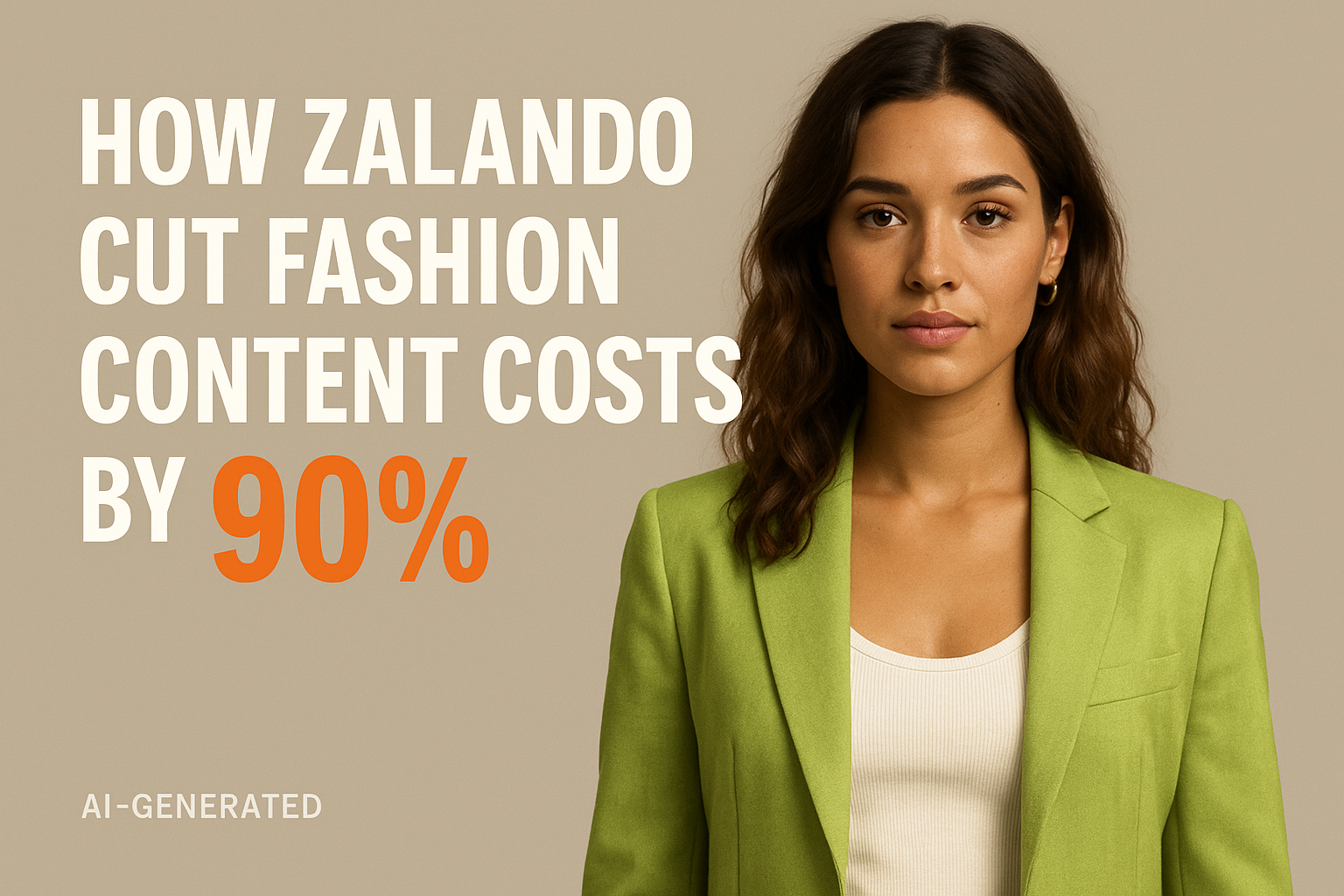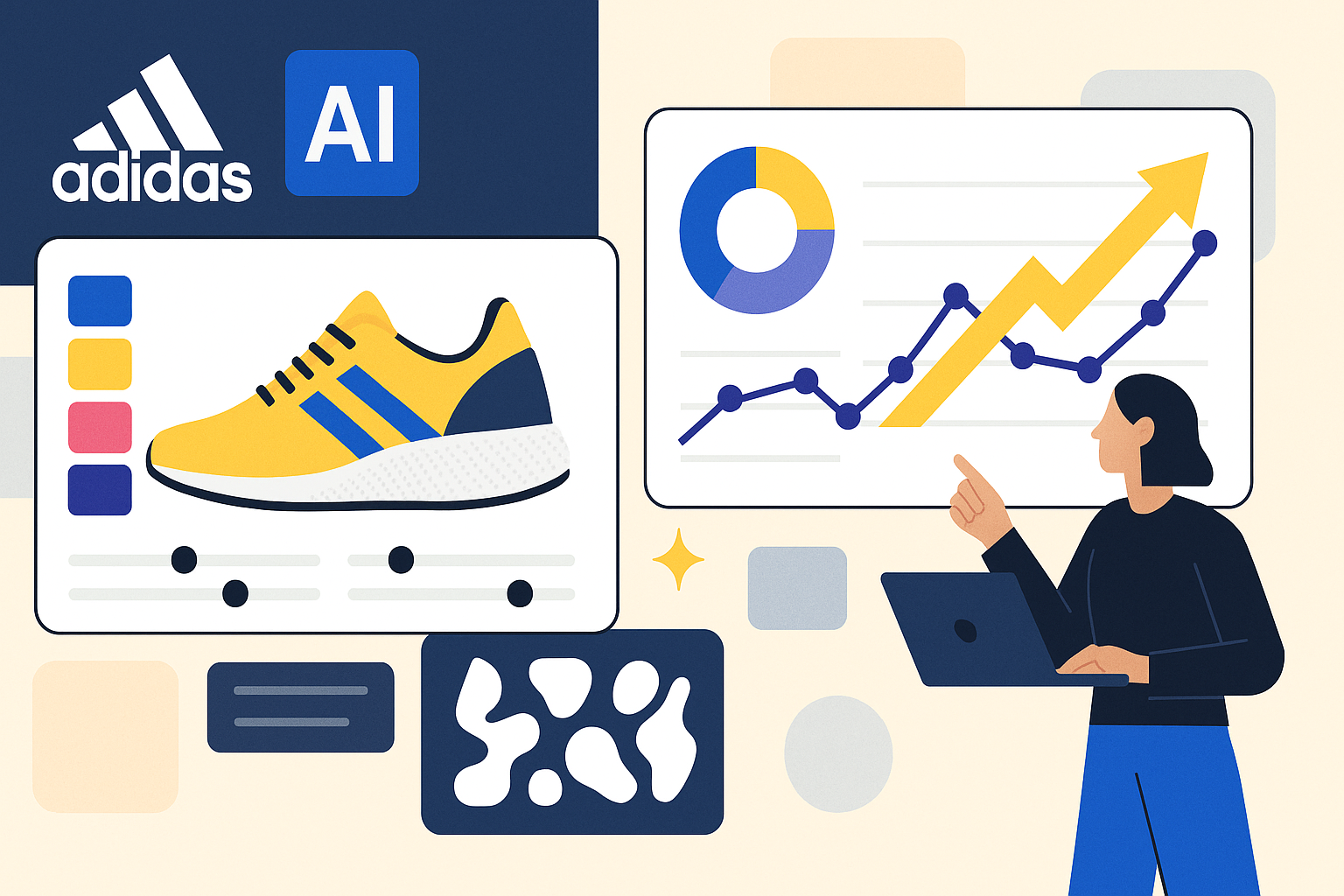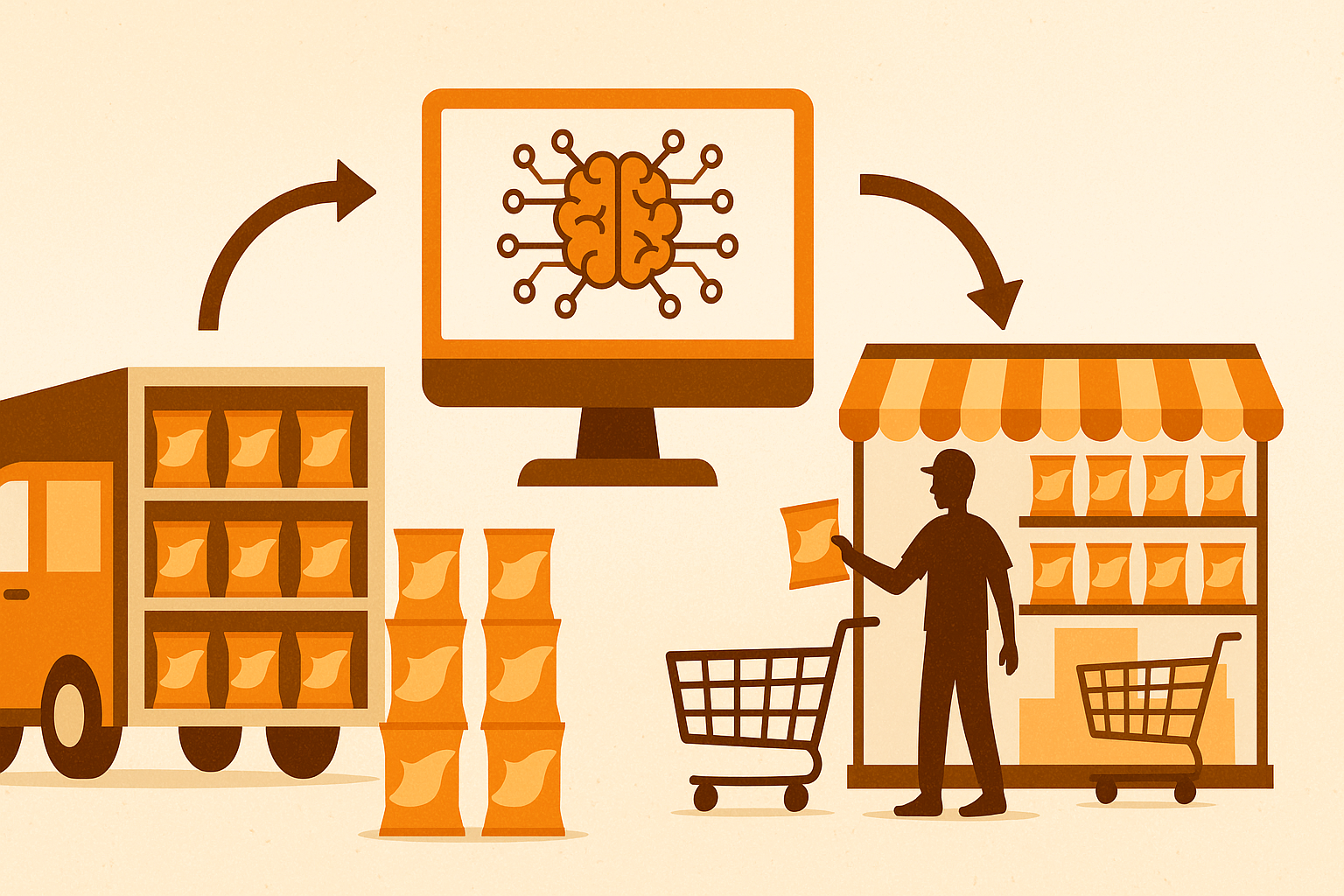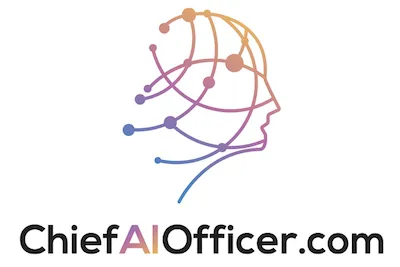Seventy percent of Zalando’s editorial images are now AI-generated. Not stock photos with filters. Not templates with minor tweaks. Full photorealistic fashion imagery featuring digital model twins wearing actual products, shot in virtual environments that don’t exist.
The timeline shift is even more shocking: what used to take six to eight weeks now happens in three to four days. Campaign costs dropped 90%. And here’s the part that confuses everyone: Zalando’s human creative teams are busier than ever.
This isn’t a story about AI replacing jobs. It’s about a European fashion giant discovering that the bottleneck in fashion marketing was never creative talent. It was time and physics.
The Impossible Math of Fashion Marketing
Fashion operates on a cycle that makes no logical sense when you examine it closely. Trends emerge on TikTok Tuesday morning. By Wednesday afternoon, they’re dominating Instagram Reels. Thursday, every fashion retailer needs content featuring that trend to stay relevant. By the following Tuesday, the trend is already aging out.
Traditional fashion photography cannot operate at this speed. You need to book models (minimum two weeks out if you’re lucky). Secure studio space or location permits. Coordinate stylists, makeup artists, photographers, and production assistants. Ship sample garments. Execute the shoot. Process raw images. Edit, color correct, and resize for various platforms.
The actual shooting might take eight hours. The coordination and logistics require six to eight weeks.
Zalando was stuck in this same cycle, watching social media trends peak and fade before their marketing teams could even respond. The “brat summer” aesthetic dominated summer 2024 feeds, but by the time traditional campaign cycles could produce relevant imagery, everyone had moved on to “mob wife” aesthetics.
Missing these cultural moments isn’t just about seeming out of touch. It directly impacts conversion rates. A 2024 study by Retail Systems found that fashion content aligned with current social trends converts 3.2 times better than generic product photography. When your imagery feels dated or disconnected from what customers are seeing across social platforms, they simply scroll past.
The Digital Twin Breakthrough
Zalando’s solution started with a partnership with ORENDT Studios focused on digital twin technology. Not the clunky CGI fashion models that plagued early e-commerce attempts. These are photorealistic replicas of real models, created using advanced generative AI that can authentically replicate clothing drape, fabric texture, body movement, and lighting conditions.
The key technical achievement is in the details that separate obviously computer-generated imagery from genuinely photorealistic content. How fabric wrinkles around elbows. How light reflects differently off silk versus cotton. How a model’s weight shifts create natural creases in clothing. These micro-details determine whether viewers perceive an image as authentic or artificial.
Traditional 3D rendering could handle some of these elements, but required massive computing resources and hours of manual adjustment for each image. Generative AI trained on millions of real fashion photographs learned to replicate these details automatically, producing images indistinguishable from traditional photography in a fraction of the time.
The practical impact? A single digital twin can now be “dressed” in dozens of different outfits, photographed in multiple virtual environments, and produce hundreds of unique product images in the time it would take to complete a single traditional photoshoot.
The Speed Advantage Nobody Saw Coming
Here’s where the timeline compression gets genuinely wild. When a viral trend emerges on social media, Zalando’s teams can now conceptualize, produce, and launch responsive campaign imagery in under 24 hours. Not rough concept sketches. Full production-ready visuals featuring their actual products styled to match the trending aesthetic.
This capability fundamentally changes the economics of trend-responsive marketing. Previously, only massive trend movements that would last months justified the investment in custom campaign photography. Smaller micro-trends that might dominate feeds for only a week or two were impossible to capitalize on because production timelines exceeded trend lifespans.
Now Zalando can create targeted visual content for trends with 7-10 day relevance windows, capturing customer attention during peak interest periods that competitors with traditional workflows simply miss entirely.
I’ve watched similar dynamics play out in B2B marketing, where companies using traditional design workflows consistently miss commenting on industry news because their content production cycle takes longer than the news cycle itself. The companies that figure out how to compress production timelines don’t just save money. They become dramatically more relevant to their audiences.
The 90% Cost Reduction Reality
The cost numbers deserve closer examination because they seem almost too good to be true. Campaign production costs dropped approximately 90%, but this doesn’t mean AI image generation costs 10% of traditional photography. The savings come from eliminating or dramatically reducing specific cost centers:
Studio and Location Costs: Completely eliminated for AI-generated content. No rental fees, no travel expenses, no location permits.
Model Booking and Usage Rights: Reduced but not eliminated. Digital twins are created from real models who receive compensation for their likeness, but ongoing usage doesn’t require booking the physical model for each shoot.
Production Crew: Significantly reduced. A traditional shoot might involve 10-15 people for a full day. AI-generated content requires 2-3 specialists operating the generation tools.
Logistics and Coordination: Nearly eliminated. No sample garment shipping, no equipment rental, no weather contingencies for outdoor shoots.
Post-Production: Dramatically streamlined. AI-generated images still require some editing and quality control, but the manual retouching required for traditional photography is largely unnecessary.
The fascinating economics emerge when you calculate cost-per-image. Traditional fashion photography might produce 50-100 usable images from a full-day shoot costing $15,000-$25,000 (including all crew, location, and coordination costs). That’s roughly $150-$500 per final image. AI-generated content can produce hundreds of images daily at costs measured in single-digit dollars per image.
This cost structure enables entirely new approaches to content strategy. Zalando can now produce region-specific content for individual European markets, create multiple versions of campaigns for A/B testing, and develop personalized visual content at scale that would be economically impossible with traditional photography.
The Human-AI Collaboration Model
Here’s the counterintuitive part that trips up most discussions about AI in creative industries: Zalando’s adoption of AI image generation didn’t reduce their creative headcount. Their teams are doing different work, not less work.
Traditional fashion shoots involve significant time spent on logistics rather than creativity. Booking models, coordinating schedules, managing sample shipments, and dealing with weather delays consume enormous creative energy that could be directed toward actual creative decisions.
With AI-generated imagery, creative teams spend their time on what actually matters: conceptualizing aesthetics, making styling decisions, selecting which trends to respond to, and ensuring brand consistency across massive volumes of content. The tedious execution work gets automated while the strategic creative work expands.
The teams I’ve consulted with in other industries report similar patterns. When automation removes repetitive execution tasks, creative professionals don’t become redundant. They become more strategic, spending their time on higher-value decisions that AI can’t make independently.
Zalando maintains that traditional fashion shoots remain essential for hero campaigns, brand storytelling, and situations where the creative vision requires specific physical locations or complex lighting setups that AI can’t yet replicate convincingly. The AI tools handle the volume work (seasonal product imagery, trend-responsive content, market-specific variations) while human photographers focus on signature creative work that defines brand identity.
The Competitive Moat Nobody Talks About
The real advantage isn’t just that Zalando can produce content faster and cheaper. It’s that they’re building a proprietary dataset and expertise that becomes increasingly difficult for competitors to replicate.
Every AI-generated image they produce creates training data that improves their models. Every creative decision their teams make trains the systems to better understand their brand aesthetic. The digital twins they’ve developed become more versatile and realistic with each use. This creates a compounding advantage where early adoption accelerates future capabilities.
Traditional fashion retailers watching from the sidelines face a catch-22: They need to invest in AI image generation to remain competitive, but Zalando’s 18-24 month head start means any AI tools they implement will be working with less training data and less refined processes. The gap widens over time rather than narrowing.
Similar dynamics played out in recommendation algorithms a decade ago. Amazon’s early investment in recommendation systems created a data advantage that competitors still struggle to match because their systems learn from every customer interaction, compounding their effectiveness over time.
The Trend Alignment Advantage
Fashion is fundamentally about cultural relevance and timing. A perfectly executed campaign featuring last month’s trending aesthetic performs worse than a mediocre campaign perfectly aligned with current trends. AI image generation shifted competitive advantage from production quality to cultural timing.
When “brat summer” emerged as a dominant aesthetic in mid-2024 (lime green, rebellious energy, Y2K nostalgia), Zalando could immediately produce campaign imagery featuring their products styled within that aesthetic. Competitors using traditional workflows either missed the trend entirely or launched responsive campaigns weeks after peak interest had passed.
The “mob wife” aesthetic that followed showed the same pattern. Oversized sunglasses, fur coats, maximalist jewelry, and old-money luxury emerged as a counter-trend to minimalism. Zalando’s ability to produce relevant imagery within days of the trend emerging meant they captured customer attention during peak search and interest periods.
This creates a feedback loop: customers seeking trend-aligned products find Zalando’s imagery most relevant, increasing engagement and conversion. Higher engagement signals to platform algorithms that Zalando’s content is more valuable, increasing organic reach. Increased reach drives more conversions, funding additional content production that maintains the advantage.
The Technical Architecture Most People Miss
The underlying technology enabling this transformation isn’t a single AI model. It’s an integrated system combining multiple specialized models working together:
Digital Twin Generation: Models trained specifically on fashion photography that can replicate realistic human appearance and movement while maintaining consistent identity across images.
Fabric and Texture Rendering: Specialized models that understand how different materials behave under various lighting conditions, ensuring wool looks like wool and silk looks like silk.
Lighting and Environment Simulation: Models that can replicate studio lighting setups or natural outdoor lighting conditions with photorealistic accuracy.
Style Transfer and Aesthetic Matching: Models that can adapt imagery to match specific aesthetic trends while maintaining product accuracy.
The sophistication lies in how these models work together seamlessly, with outputs from one feeding into inputs for another. The creative team makes high-level decisions (which products to feature, which aesthetic to target, which environment to simulate) while the AI system handles the technical execution of rendering those decisions into photorealistic imagery.
The Customer Engagement Surprise
Zalando reported increased customer engagement with AI-generated imagery compared to traditional photography. This initially seemed counterintuitive. Shouldn’t customers prefer “authentic” photography featuring real models in real locations?
The explanation reveals something interesting about customer priorities. Customers don’t care whether an image is AI-generated or traditionally photographed. They care whether the imagery feels current, relevant, and aligned with trends they’re interested in.
AI-generated content’s engagement advantage comes from its freshness and trend alignment, not from any inherent preference for artificial imagery over traditional photography. When content matches what customers are seeing across social media, feeling culturally current and relevant, they engage with it more regardless of production method.
This suggests that the historical advantage of traditional photography (authenticity, realism, emotional resonance) might matter less than previously assumed. The real driver of engagement is cultural relevance and timing, areas where AI-generated content now holds structural advantages.
The Market Expansion Opportunity
Zalando operates across numerous European markets, each with distinct aesthetic preferences, cultural trends, and seasonal timing differences. Traditional content production made it economically impossible to create truly localized imagery for each market. The best they could do was generic pan-European content with some regional adaptation.
AI image generation changes this calculus completely. Creating Germany-specific, France-specific, and Italy-specific campaign imagery costs essentially the same as creating single universal campaigns. The same digital twins can be styled differently, placed in culturally relevant environments, and matched to region-specific aesthetic trends with minimal additional cost.
This enables hyper-localization that was previously reserved for global mega-brands with enormous marketing budgets. A mid-sized fashion retailer can now produce content that feels specifically tailored to individual markets without the traditional cost multiplier associated with market-specific creative production.
The Implementation Reality Check
Rolling out AI image generation at Zalando’s scale wasn’t a simple technology purchase. It required significant investment in several areas:
Technical Infrastructure: Computing resources capable of running large generative models at scale, storage systems for managing massive image libraries, and content delivery networks optimized for serving high-resolution imagery.
Team Training: Creative teams needed to learn new workflows, understand AI capabilities and limitations, and develop quality control processes for AI-generated content.
Legal and Ethical Frameworks: Establishing guidelines for model consent and compensation, ensuring AI-generated imagery meets advertising standards, and creating processes for transparency about content generation methods.
Integration with Existing Systems: Connecting AI generation tools with product databases, content management systems, and marketing automation platforms.
The timeline from initial experimentation to 70% AI-generated editorial content likely spanned 18-24 months, requiring sustained investment and commitment even when early results weren’t perfect.
What This Means for Fashion Marketing
Zalando’s success creates pressure across the fashion industry. Competitors watching from the sidelines face increasing disadvantages in speed, cost efficiency, and trend responsiveness. The question shifts from “should we adopt AI image generation?” to “how quickly can we implement it before the competitive gap becomes insurmountable?”
The companies that will struggle most are those treating this as primarily a cost-reduction opportunity rather than a strategic capability. Yes, the 90% cost reduction is significant. But the real advantage is the ability to operate at different speeds and scales than competitors still constrained by traditional production timelines.
Fashion marketing is shifting from a game of production quality to a game of cultural timing and relevance. The brands that understand this transition and build their content strategies accordingly will dominate their categories. Those that continue optimizing for traditional photography quality while missing trend windows will progressively lose relevance regardless of their creative talent.
Your Strategic Response
If you’re in fashion marketing, the window for early adoption advantages is closing but not closed. The next 12-18 months will separate the brands that successfully transition to AI-augmented content production from those that become permanently disadvantaged by their slower traditional workflows.
Start by identifying your highest-volume, lowest-creativity content needs. Seasonal product photography, size variation imagery, and regional adaptations are ideal candidates for AI generation. Keep traditional photography for hero campaigns and brand-defining creative work where human vision matters most.
Experiment with digital twin technology for your most frequently featured models. Build your proprietary dataset. Develop internal expertise. The compounding advantages of early adoption come from accumulated learning and data, not from waiting for perfect technology.
The fashion brands thriving in 2027 will be those that figured out how to combine human creative vision with AI execution capabilities in 2025. The ones still debating whether AI image generation is “real photography” will be explaining declining market share to their boards.
Zalando proved that 70% AI-generated content isn’t a compromise. It’s a competitive weapon.




